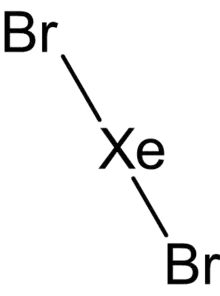 | |
| Names | |
|---|---|
| IUPAC name
Dibromoxenon | |
Other names
| |
| Identifiers | |
3D model (JSmol) |
|
| ChemSpider | |
PubChem CID |
|
CompTox Dashboard (EPA) |
|
| |
| Properties | |
| XeBr2 | |
| Molar mass | 291.10 g/mol |
| Thermochemistry | |
Gibbs free energy (ΔfG⦵) |
32.5(calculated)[1] |
| Related compounds | |
Other anions |
Xenon difluoride Xenon dichloride |
Except where otherwise noted, data are given for materials in their standard state (at 25 °C [77 °F], 100 kPa).
Infobox references | |
Xenon dibromide is an unstable chemical compound with the chemical formula XeBr2. It was only produced by the decomposition of iodine-129:[2]
- 129IBr2– → XeBr2 + e–
Attempts to prepare this compound by combining elemental xenon and bromine only resulted in the XeBr radical.[3] This compound is expected to be less stable than xenon difluoride and xenon dichloride. It is also expected to decompose to xenon and bromine.[1]
References
- 1 2 Meng-Sheng Liao; Qian-Er Zhang (1998). "Chemical Bonding in XeF2, XeF4, KrF2, KrF4, RnF2, XeCl2, and XeBr2: From the Gas Phase to the Solid State". The Journal of Physical Chemistry A. 102 (52): 10647. Bibcode:1998JPCA..10210647L. doi:10.1021/jp9825516.
- ↑ A. H. Cockett; K. C. Smith; Neil Bartlett (2013). The Chemistry of the Monatomic Gases (Ebook). Elsevier Science. p. 267. ISBN 9781483157368.
- ↑ Shuaibov, A.K.; K. C. Smith; Neil Bartlett (2004). "A Broadband Excimer-Halogen Emitter Utilizing Xenon Bromide and Iodide". High Temperature. Springer Link. 42 (4): 645–647. doi:10.1023/B:HITE.0000039995.15986.ec. S2CID 122335160.
This article is issued from Wikipedia. The text is licensed under Creative Commons - Attribution - Sharealike. Additional terms may apply for the media files.